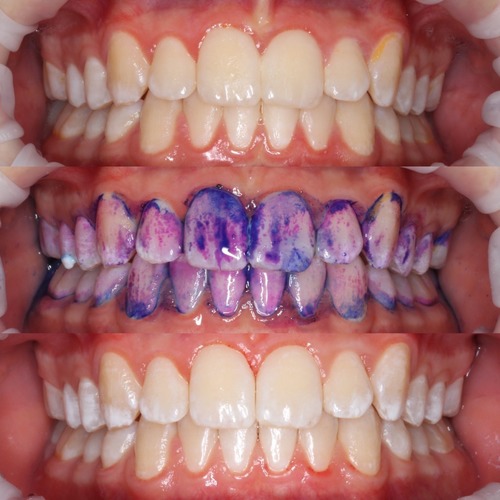
Teeth before hygiene, chemical agent for staining plaque (used for educational purposes so that the patient can see uncleanable areas) and condition after hygiene.
There are a lot of questions about brushing your teeth, so let's go over the main ones:
- What happens if you don't brush your teeth?
- Is it possible to brush your teeth rarely, but go to the dentist from time to time so that he "brushes them powerfully" for you?
- How is dental cleaning done in dentistry?
- ?
- ?
- ? ?
- , , ?
- , , ?
- ?
- — ?
- — ?
- - ?
? , ?
The oral cavity is a place of incessant battle of about 700 types of microflora. Saliva is one of the most active body fluids. On the one hand, it must neutralize biological threats from the outside world, on the other hand, it must pre-process food, and on the third hand, it must protect the teeth. From the point of view of evolutionary biodesign, the problem is solved very well if you eat what evolutionary biodesign offers from the outside world. For example, apples, large animals with tough meat, then unripe wild pears, carrots, and so on. Hard food perfectly cleans teeth without your help.
Several tens of thousands of years ago, something went wrong, and man learned to cook food on fire. This gave rise to the first problems, but then not very significant ones, since in the light of the development of medicine and the lack of antibiotics, teeth were not the most important problem. But already in the twentieth century, when fast food, forced high-carbohydrate diets and soft, inconsistent foods entered the masses, real difficulties began.
Dental plaque is a biofilm made from bacteria that sticks to your teeth and protects against aggressive saliva and other cleaning methods. Adhesive microfragments of food, which remain in the form of such glue on the teeth, help bacteria very much in this. For example, crumbly biscuits or pizza dough combine with dead cells to create a good bio-glue. Bacteria settle on it and begin to colonize your tooth. Their goal is to get inside and set up a base there. We call this tooth decay. Most often, developed caries is just an amphora-shaped one: a small inlet and a sea of destruction inside the tooth.
This is how the patient comes in:

Here is the hidden caries revealed:
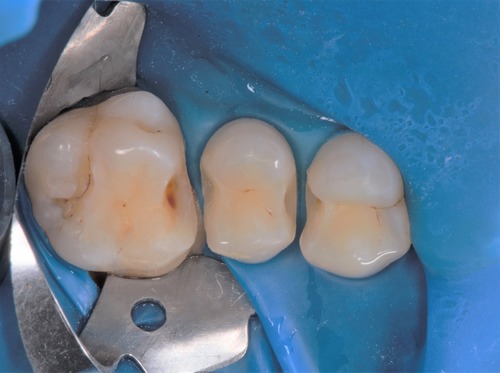
And here is the end of the therapist's work:

Latent caries can, in principle, be detected by radiography and transillumination.
If this biofilm is removed in time, there will be no caries. But it is strong enough, so either a strong antiseptic is needed (the same alcohol, which at the same time harms other parts of the system already starting from the oral cavity), or mechanical treatment (with an apple or a toothbrush). Large amounts of saliva partially wash away the films, but not all: for example, they remain at the contact points and under the edge of the gums.
Several layers of biofilm form calculus - tartar. This is a rather disgusting bacteria hardening. It is disgusting for its unique smell and taste (which your partner often feels with every kiss). But from the point of view of medicine, this is not the main thing. The main thing is that tartar still presses on the gums and impedes the blood supply to the gums, creating complex inflammations. Well, nobody ruled out caries. Imagine that a few grains of sand have sunk into your hand, and they stick out there for months, gradually increasing. Tartar is about the same unpleasant, but due to the peculiarities of innervation, you hardly feel them.
So, if you don't brush your teeth, then a biofilm will form very quickly. And if you do not touch the biofilm, then a calculus is formed, which starts many unpleasant processes. The accepted medical practice is to brush your teeth after breakfast and dinner.
When is it more important to brush your teeth - in the morning or in the evening?
It may seem that brushing your teeth is equally important in the morning and in the evening. But no, evening cleaning is much more important. At night, the body produces less saliva (this is one of the reasons why you have a dry mouth in the morning). Less saliva on your teeth means less protection. Less protection means faster biofilm formation.
That is, if in the morning you brush your teeth so that your mouth does not smell when talking, then in the evening you need to brush your teeth for medical reasons. Most teeth brushing techniques suggest that the evening brushing should be longer than the morning.
Is it possible to brush your teeth rarely, but go to the dentist from time to time so that he "brushes them powerfully" for you?
As a doctor, I have to say no, but actually yes. That is, in any case, you do so, because you are far from reaching the places that need to be cleaned. Usually, the patient brushes his teeth either with parallel frictions "from the elbow" along the frontal surface, or haphazardly and randomly on all surfaces with approximately the same frictions. As a result, he has excellent clean frontal surfaces of the anterior incisors, excellent condition of the edges of the teeth and chewing surfaces, but almost always a tendency to caries on the far surface of the back teeth and on the inner surface near the gums of the front teeth. That is, like this:
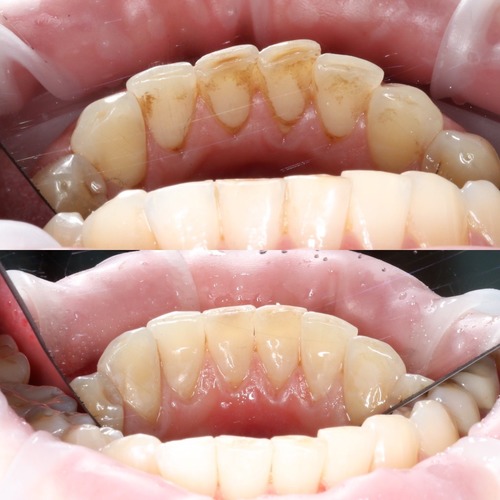
Before and after hygiene.
It can take approximately two weeks from biofilm formation to the earliest cases of tooth decay. After that, there is still time for the development of caries, when it can be stopped in time with little tissue loss without drilling into the tooth. That is, if the patient somehow brushes his teeth, then an interval of three to four months is considered safe, after which you need to look at early caries. Moreover, according to various sources, from 40 to 60% of cases of caries in the initial stages are not diagnosed on examinations, therefore it is very important to use hardware research methods before hygiene. In particular, staining and interproximal images with minimal radiation exposure work very well.
Just in case, typical doses of radiation exposure:
CT scan of the abdominal cavity and pelvis - 10 mSv.
Chest CT scan - 7 mSv.
Chest X-ray - 0.1 mSv.
Aimed shot - 0.003 mSv.
Cone beam tomography of the head - 0.01–0.014 mSv.
Intraoral radiography - 0.005 mSv.
The average annual radiation dose is 0.0022 mSv / inhabitant.
Eat one banana - 0.0001 mSv.
Screening at the airport with an X-ray scanner - 0.0005 mSv.
Our device:
Interproximally three to four teeth - 0.003 mSv.
Eight teeth in one jaw - 0.04 mSv.
Eight teeth on two jaws - 0.06 mSv.
Both jaws - 0.07 mSv.
The whole head is 0.1 mSv.
That is, if you at least somehow correctly and more or less evenly brush your teeth, then you should go to the dentist every three to four months, because after six months we already see caries. Modern techniques recommend just such an interval, and I would like to believe in such a discipline.
Going to the clinic for hygiene and diagnostics costs, on average, five to six times cheaper than treating the consequences in the form of advanced caries. For those who use dental VHI: please note that, most likely, hygiene and small caries are in your coating, but moderate and severe forms are not. That is, for you it is a shareware way to keep your teeth in order.
Is it possible to independently assess areas of biological damage?
Yes, you can. To do this, you need to buy at the nearest pharmacy either Curaprox, Dinal tablets, or Curaprox, PresiDENT liquid. The tablets are chewed to a cheerful foam and spit out. Considering that there you need to carefully and thoughtfully read the instructions to the end, it is better to buy a liquid, it is applied with a special swab or cotton swab. It will turn out more reliable. But if you have not been on hygiene for the last two or three months, then it is better to do it on Friday evening. In fact, it rinses off almost immediately, but there is a chance that especially violent lesions will be stained for about 50 hours. This happens quite rarely and with poor hygiene, but it is a matter of chance.
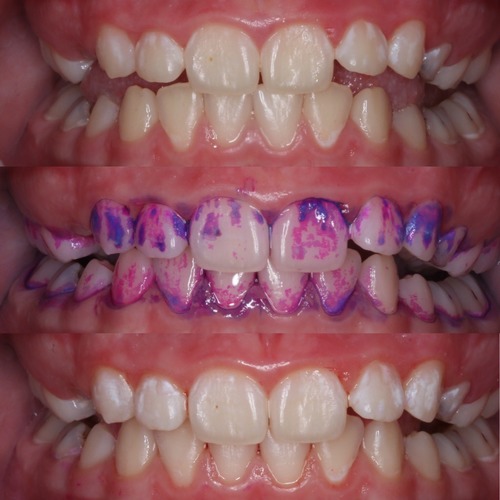
What happens during dental hygiene?
The hygienist first looks at the size of the stones. If there are very large ones, then we break them with ultrasound. Then, manually using rotating brushes, rubber bands and paste, we work with a bloom. If you need to crawl under the gums, then there are curette hooks that can be used to clean difficult areas and smooth the surface of the roots so that rotting food does not linger there. Then each gap between the teeth is processed with floss and fine sandpaper. Then the teeth are polished. The next stage is strengthening: a disposable mouthguard with remineralizing solution is placed on the teeth. It then discusses how best to brush your teeth in the future.
Then there are two approaches: "industrial" and "archaeological". If you see sandblasting on soda, then you are a hygienist who wants to quickly and powerfully. However, due to the design features of this equipment, it is very difficult to ensure the balance of efficiency and safety, therefore, we consider this approach not the best in terms of attitude to the tissues of the oral cavity (the rough surface of the tooth after a large abrasive gives great adhesion to sticky food, gums are often damaged). Manufacturing companies are trying to solve this problem, but so far our choice is mechanical contact cleaning.
Various chemical agents and “mild” abrasives can be used during cleaning. If there is inflammation of the gums (which is often associated with "blockages" of stones), then treatment with special antiseptics and agents may be needed to relieve the inflammation. In this case, the technique is often divided into two: first, the calculi above the gum line are removed, then five to seven days pass until the inflammation caused by them subsides, and then it is relatively safe to work with the stones below. If you do everything in one go, it will not be very beautiful: blood in all directions. Not that we were sorry to arrange this, it just prevents us from correctly assessing the results of work inside this bloody mess. Therefore, we love when it is clean, the patient does not break free and does not panic. Gingivitis from the middle stage = two doses, one week apart.
The procedure itself is painless, but sometimes patients are ticklish. Sometimes the grinding of a tool in the teeth causes unpleasant emotions. There is no problem to do everything under local anesthesia: this is just the case when you don't have to be afraid to ask her.
Hygiene is done before any more or less serious intervention, since it allows you to correctly diagnose later and correctly take into account the shape of the teeth. Well, the fewer dangerous bacteria during invasive procedures near the field, the better.
That is, it is enough to properly brush your teeth, and there will be no problems, right?
Right. But we still work on all areas, all teeth are polished.
How to properly brush your teeth?
A colleague of mine recently wrote about the characteristic "programmer teeth" . About half of the problems in these cases are associated with insufficient salivation of the oral cavity: this is a completely predictable consequence of night work, stressful focus on the task and various problems with food. Since I have very little faith in the fact that someone, after reading, will suddenly begin to eat right or change the daily routine, let's tell you how to properly brush your teeth according to the Swiss method. It is most suitable for those who have a busy schedule, stress and unhealthy diet. That is, for all adults in large cities.
It is called the BASS technique (more precisely, the extended technique of brushing teeth according to Bass). She is one of about two dozen techniques available. Please note that we still do not know which technique is best for brushing your teeth. If you are interested, this question was raised in Nature: here is an analysis of recommendations from various sources, textbooks and a selection of studies. The result boils down to the fact that for children the Bass technique is too difficult, but for adults it gives the best result. Moreover, all studies that numerically confirm this were carried out over a fairly short observation period.
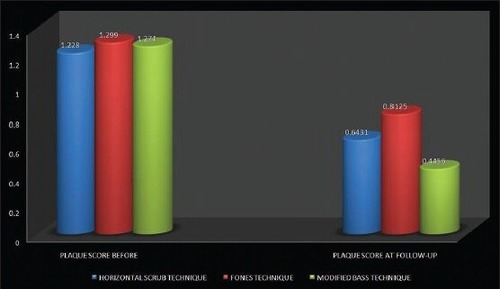
Sorry for the compression: this is the original picture quality from the studyon 180 healthy children. Blue was-now - this is the horizontal cleaning you are accustomed to, red - circular with closed teeth, green - according to Bass. Here is another study with a long observation period. This is partly due to the fact that it is difficult to follow patients and stand above their souls every time they brush their teeth.
Nevertheless, this method is currently one of the best, judging by scientific data and practice. Here's what to do:
1. Buy the soft toothbrush with the most fluff. The shape is strictly straight (both the handle and the fleecy part without bends and protrusions). You still can't do anything better with a hard or medium-hard brush, but a soft one cleans much better and without damage: we will work on the border with the gum.
I recommend Curaprox ultrasoft 5460, Revyline, TePe brushes, but you can choose any that are similar.
2. Take the brush like a handle (not a fist) and place it at an angle of 45 degrees to the gum vertically so that the bristles enter as if under the edge of the gums. You will feel it. Half of the brush should be on the crown of the tooth, half on the gum. Then start moving with the brush to get such long ovals. Gradually work your way over all the teeth from the front, working on the edge of the gums.

Do not move the brush with your elbow or forearm, only your hand. Very soft smooth movements should be obtained.
3. Brush the inside of the teeth in the same way, but keep the brush upright.
4. After that, make the usual horizontal movements along the edges of the teeth and their frontal surfaces.
The procedure is slower than the usual haphazard brushing, since you need to go over all the teeth very carefully at the edge with the gum. It takes three minutes in the morning, more than five minutes in the evening. In Switzerland, they brush their teeth for seven to ten minutes, leaving the bathroom with a brush without toothpaste. This is a very good practice, and I recommend it: just grab a brush and sit down to watch YouTube or do something else and work gently along the edge of the gum. The meaning of the method is not only that while brushing your teeth you can do something else (fortunately, there is no paste), but also that you do not see your reflection. When you operate the brush according to visual reference points, it always drastically reduces the quality of cleaning compared to cleaning without a mirror, because different sensory systems are involved. And sensations are more important here than sight.
Is it true that the brush should be thrown out when at least one villi deviates from the vertical?
Yes, if the pile on your brush is no longer vertical, it is better to change it. Usually, the brushes are changed about once a month, but the quality options from the recommendations above, with the right manual skills, can be changed every three months.
It is also very important to change the brush after hygiene at the dentist: the microbiota of the oral cavity is "restarted" for you, and it is not very good to bring in the old pathogenic one from the old brush.
Pharmacies sell disposable toothbrushes with dry granules and beneficial enzymes. I recommend carrying this with you in your bag: it's a great option if you suddenly realize that it is better to look and smell perfect.
Why do you need tongue scrapers, interdental brushes, dental floss and everything else?
The tongue scraper is very important because the tongue also needs to be cleaned. You can do this with a separate brush, but with a scraper it is much more convenient and efficient. I recommend double scrapers, here are a couple of examples: Curaprox double and TePe. It is better to use a scraper before the main cleaning, passing over the tongue literally three to four times.
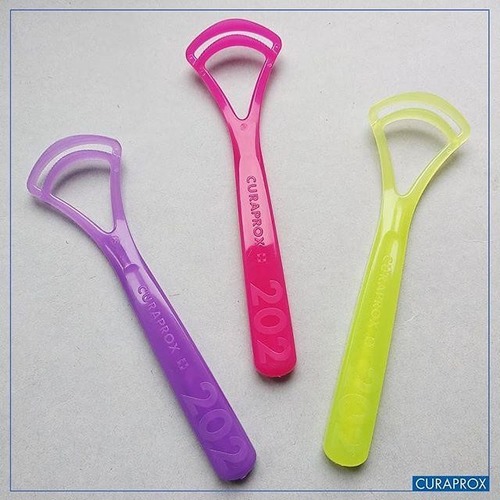
Dental floss is not recommended at this time. More precisely, it is very good for cleaning fiber from meat after a restaurant (and better than not having it), but bad if you don't know how to use it correctly. And almost no one knows how: it should not touch the gums. Therefore, a more modern approach is the interdental brushes. They look like this:

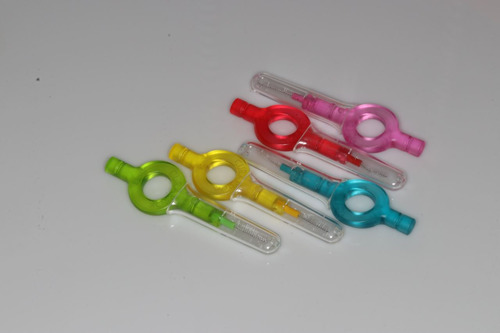
As you can see, they are different colors for different gaps. You need to pick them up with a doctor using a special probe that is inserted between specific pairs of teeth. It is better not to do this on your own. Summing up: it is better to forget about the brushes, as well as about the thread, until the doctor directly advises you.
Mouthwash is good in the afternoon after meals if it is alcohol-free. It works better with alcohol, but damages teeth and soft tissues (primarily mucous membranes). Without alcohol, it is worse and not suitable as a substitute for a full-fledged cleaning, that is, it is better to use it only during the day if you need to get rid of the smell or clean your mouth after eating.
There are also foams like Water Dent - they restore the environment to slightly alkaline, which is much better than the acidic environment after meals (and especially after coffee). Some mouth rinses work the same way.

Is the irrigator working?
The toothbrush removes about 70% of bio-foci. The rest are located where it is mechanically impossible to reach, for example, in contact points. So yes, the irrigator complements your regular dental cleaning very well. If you can, use it every time. But just do not take stationary ones that require connection to a household power supply. Practice shows that my patients do not use these because of the difficulty of switching on in the bathroom. It is better to use mobiles with batteries, they are much easier and always at hand near the sink.
What about gum?
Chewing gum is a very good option for cleaning your teeth after eating. But do not use it for more than three to four minutes and do not take gum with sugars.
Which pasta to choose?
Any with low abrasiveness is suitable. Calcium pastes work, but with a long exposure of the paste on the teeth. I do not recommend whitening pastes, pastes for smokers and coffee lovers. Look at the index of abrasiveness, the best options are in the region of RDA 50-70 units. In the morning, you can use antibacterial, but in the evening - only the usual. I recommend such pastes as Biorepair Night, Apadent, ROCS Active Calcium, Curaprox. I don't really recommend the Russian versions of Colgate and Blendamed: they have some changes relative to the foreign line-up, which makes the environment more aggressive.
Milk and cottage cheese do not affect the teeth (calcium from them hardly gets into the enamel). The pastes have little effect, but with 10 minutes of cleansing, the results are noticeable. Usually, when a patient has problems with calcium, special gels are prescribed in courses of two weeks every three months.
A couple of links to research .
If I am not reaching my back wisdom teeth, what should I do?
You can leave them to the doctor, you can try to clean them. But let's talk about wisdom teeth and their purpose separately.
Is it true that dentists don't want to teach us how to brush our teeth?
It may seem that the dentist has a vested interest in you brushing your teeth incorrectly. Because if you teach it correctly, then you will not come back with caries or no tooth at all.
There are two exceptions:
- Hygienists who want to help the patient. This is either an ordinary human desire to do well, or the basis of the clinic's work: good service is noticeable, and such a clinic is much more trusted (that is, they return much more often, and if a patient with a clinic is 10 years old, then sooner or later he will need expensive services purely statistically) ...
- And the manufacturers of paste-brushes-irrigators understand that the correct set of consumables and instruments in the patient's hands brings them quite a lot, so they try to teach people the right processes, including through the hygienists of the clinics.
We created the clinic as a way to make money at the cutting edge of applied science, but very quickly clients began to tell their friends about us as one of the most caring dentistry in Moscow. We counted on "the most advanced technically", but that's okay too. I hope that my contribution to the “most caring” one, because I explain in great detail and in detail how not to get into the chair next time. And with me you can practice brushing your teeth separately from the reception: the hygiene lesson lasts 40-60 minutes, and the price includes the necessary set of brushes and brushes.
PS If you get to our clinics, then say that you are from Habr, there will be a 5% discount.